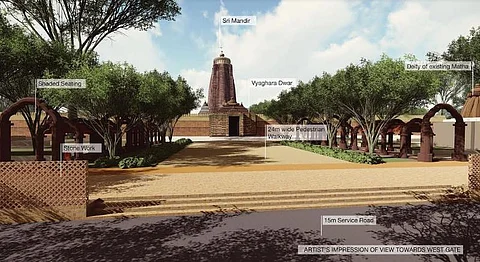
- HOMEGROWN WORLD
- #HGCREATORS
- #HGEXPLORE
- #HGVOICES
- #HGSHOP
- CAREERS
- ABOUT US
- CONTACT US

The Naveen Patnaik-led Odisha Government has geared up to transform the spiritual town of Puri into a world-class heritage city with multiple redevelopment projects. It has sanctioned 13 projects worth Rs 750 crore under the Augmentation of Basic Amenities and Development of Heritage and Architecture (ABADHA) scheme.
The scheme has been implemented to preserve and revitalise the iconic city of Puri, which is one of the most preferred destinations for ‘Spiritual Tourism’ globally. Every year in July, Puri hosts the world’s largest car festival known as Lord Jagannath Rath Yatra.
The project will further aim to reflect the city’s unique vibrant character by encouraging planned development.
The ABADHA project will meticulously develop the town in line with the Kalingan architecture known for its grandeur. For the same reason, the Shree Jagannath Temple Administration (SJTA) led by Dr. Krishan Kumar, IAS and Secretary Works Department, Government of Odisha , has already initiated a request to the Steel and Mining Department of the state for the operationalisation of Khondolite quarries.
Khondolite is an integral element of the Kalingan architecture; the two most iconic architectures of Odisha - the Konark Sun Temple and the Lord Jagannath Temple are primarily constructed from the khondolite rocks. Named after the ‘Khond’ tribes of Odisha, Khondolite is a metamorphic-sedimentary rock. It is a banded structure, brownish in colour, and comprises of quartz, graphite and other minerals. It is found prominently in the Eastern ghats between Vijaywada and Cuttack.
Its porosity varies from 7.8 per cent to 12.4 percent which is why it is susceptible to weathering, which results in concerting the material of either Kaolin with quartz and ferric hydroxide or in more advanced stages, a laterite material containing mainly hydroxides of iron and aluminium.
For stone conservation, a vast number of materials are used, depending on their composition. For Khondalite strengtheners, a base of ethyl silicate is used; on penetrating the stone, it converts back into silica or quartz and becomes a mineral binder (silica gel), which combines with stone. It allows the stone to “breathe”, thereby eliminating moisture (water vapour) from the stones.
The Puri temple was constructed from Khondalite, primarily for the ease of work, engraving statues, panels, moulds etc. These stones have nevertheless withstood Puri’s saline atmosphere comprising sulphate, chloride, nitrates and other dissolved solids for more than 800 years.
However, Khondalite being a comparatively weak material, it still disintegrates due to pollution and water action. As a result, the loss of beauty of the statues and engravings cannot be altogether prevented. At this point in time, especially after the Cyclone Fani, there has risen an urgent requirement for the procurement of these khondalite rocks to aid in repair and restoration work of the temple.
The project also aims to create a new link-road, 1.5 km long from Puri bypass at Malatipatapur to Jagganath Ballav Math which will be connected by a trumpet bridge named Shree Setu Project.
The project will also construct and modernize the Raghunandan Library by digitising the palm leaf manuscripts and books. Other articles and important books related to the Srimandir and Jagannath culture will be kept in the modern library.
Atharnala will be developed as an iconic pedestrian heritage bridge with the support of the Archaeological Survey of India (ASI). A lake will also be developed on 28 acres of land at a cost of Rs 35 crores.
The redevelopment of the Acharya Harihar Square involves the relocation of the DRDA ((District Rural Development Agency) market building, the Sadbhavana Griha and the DSWO (District Social Welfare Officer) office. The primary aim of the project is to widen the road and construct a public plaza for which 0.8 acre is available. The project estimated at Rs 3.5 crore aims at creating an active space with a landmark sculpture that can build an image and identity for the place.
The government is further giving a special relief and rehabilitation package for those who faced displacement during the ongoing eviction drive around the Puri Jagannath temple.
Bimalendu Ray, Joint Secretary, ABADHA Implementation Works Department said: “Puri is the heartland of Odisha, famous for its heritage buildings, culture, nature, and numerous tourist destinations. To preserve these natural, built and living heritage assets, the Government of Odisha has taken a giant step under the ABADHA scheme not only to strengthen the assets but also to enhance the aesthetic value of one of India’s most ancient heritage cities.
“The projects under ABADHA are being executed by the Works Department. The designing, planning and monitoring has been assigned to Odisha Bridge and Construction Corporation, a State government PSU. District Administration, Puri, is taking the lead role in providing land and local coordination support.”
The project has drawn criticism for the demolition of the mutts, but like iconic monuments such as the Taj Mahal and the Konark Temple which boasts of ample clear surrounding space, the project aims to make the Lord Jagannath temple the focus of the pilgrim’s experience. ABADHA further aims to modernise the functional attributes and strengthen the aesthetic and spiritual qualities of the temple precinct.
Taruka is a sports and travel writer. She is a former Asian Games Player and a British Council GREAT Scholar.
You can read her travelogues here and find her on Twitter.
If you enjoyed this article, we suggest you read:
